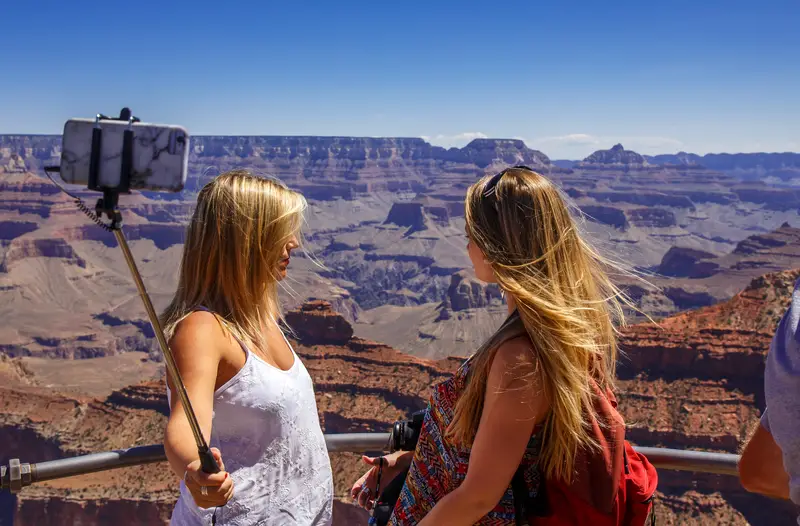Social media has turned taking photos into something much more dangerous than anyone expected. Since 2008, at least 480 people have died while trying to capture the perfect selfie, making it statistically more deadly than shark attacks or lion encounters. What started as innocent photo-taking has become a global health crisis as people risk everything for likes and online validation.
The Grand Canyon claims multiple victims each year
Standing at one of America’s most famous landmarks, tourists regularly step too close to deadly cliff edges while positioning themselves for dramatic shots. The Grand Canyon has become notorious for fatal falls linked directly to people taking selfies who lose their footing on unstable ground. At least two confirmed deaths at this location involved visitors who became so focused on capturing the perfect shot that they lost awareness of the massive drop behind them. The canyon’s vast landscape creates an irresistible backdrop, but its crumbling edges and sudden weather changes make it incredibly treacherous for photo-taking.
Park rangers report that visitors routinely ignore safety barriers and warning signs while attempting to reach more photogenic spots along the rim. Many people climb over protective fencing or venture onto unmarked trails where the ground can give way without warning. The pursuit of unique angles and dramatic lighting leads tourists to dangerous overlooks during sunrise and sunset hours when visibility becomes limited. Emergency rescue teams now respond to multiple selfie-related incidents each month, with many victims suffering serious injuries even when they survive the initial fall.
Men in their twenties face the highest risk
Research published in medical journals shows that men aged 20-29 represent the largest group of selfie-related fatalities worldwide. This demographic appears most willing to take extreme risks for social media content, often underestimating dangerous situations while overestimating their physical abilities. Between October 2011 and November 2017 alone, at least 259 people died while attempting to capture photos in hazardous locations. The combination of youth, confidence, and social media pressure creates a perfect storm for risky behavior that older generations tend to avoid.
Young men frequently attempt stunts like hanging from bridges, climbing unstable structures, or positioning themselves on narrow ledges without proper safety equipment. Their willingness to push boundaries for increasingly dramatic shots has led to fatalities involving electrocution, drowning, and falls from extreme heights. Social media algorithms reward bold content with more views and engagement, creating additional incentive for dangerous photo opportunities. Many victims had previously posted risky selfies without incident, leading them to believe they could continue escalating their stunts safely.
Norway’s scenic cliffs have become death traps
Some of the world’s most beautiful landscapes have turned into selfie graveyards as tourists flock to capture Instagram-worthy shots. Norway features multiple locations where visitors have fallen to their deaths while taking photos, including Kjeragbolten, a rock formation suspended 1,000 meters above ground between fjords. Preikestolen cliff recently claimed a Spanish tourist who fell while attempting to photograph the dramatic scenery. Trolltunga, a rock formation resembling a troll’s tongue, became the site where a 24-year-old Melbourne woman plummeted 300 meters to her death.
These Norwegian landmarks attract thousands of visitors annually who make dangerous hikes to reach photogenic spots without proper preparation or safety gear. Weather conditions can change rapidly in mountainous regions, creating slippery surfaces and reduced visibility that make photography extremely hazardous. Many tourists arrive wearing inappropriate footwear and clothing for the challenging terrain, focusing more on their appearance in photos than practical safety considerations. Local rescue services report increasing numbers of incidents as social media continues promoting these locations as must-visit selfie destinations.
Waterfalls and swimming holes create deadly traps
Water-related selfie deaths have become increasingly common as people venture into dangerous swimming areas for dramatic photos. Devil’s Pool in Zambia sits 110 meters above Victoria Falls, where swimmers approach the edge protected only by a natural wall that becomes useless against strong currents during certain seasons. The Babinda Boulders near Cairns, Australia, have claimed 21 lives since 1959, including three deaths during 2020-21 alone. This location features particularly hazardous areas called “The Chute,” a natural channel that traps swimmers underwater making escape impossible, and “The Washing Machine,” where churning waters tumble victims until they drown.
Despite safety fencing and no-swimming signs, people routinely climb barriers to reach these photogenic spots for social media content. Many victims underestimate the power of moving water and currents that can easily overpower even strong swimmers. Falls over 80 feet down waterfalls represent some of the most severe selfie-related accidents, often resulting in multiple injuries before drowning occurs. Local authorities have initiated crackdowns with officers regularly catching fence-climbers attempting to reach restricted areas, but enforcement remains challenging due to the remote nature of many locations.
Train tracks have become popular photo locations
Railway selfies represent one of the most preventable yet frequently occurring types of photo-related accidents worldwide. Train-related incidents have become so frequent in Otaru, Japan, that the city hired security guards around popular tourist photography spots to prevent accidents. Cases regularly involve people being struck by oncoming trains while concentrating on their photos, completely unaware of approaching danger until it’s too late to move to safety. The combination of heavy, fast-moving trains and distracted photographers creates an extremely deadly situation that claims lives globally.
Many people mistakenly believe they can hear trains approaching in time to move, but modern electric trains operate much more quietly than older steam engines. Photographers often wear headphones or become so focused on their camera settings that they miss warning sounds entirely. Train operators frequently cannot stop in time once they spot people on tracks, as freight and passenger trains require significant distances to come to a complete halt. Social media posts featuring railway photography continue inspiring others to attempt similar shots, perpetuating a dangerous cycle that transportation authorities struggle to combat through education and enforcement efforts.
Electrocution risks near power lines and infrastructure
Urban selfie enthusiasts face serious electrocution risks when climbing trees, buildings, or structures near power lines for elevated photo angles. High-voltage electrical systems can kill instantly through direct contact or even close proximity, as electricity can arc through air gaps to reach human bodies. Many victims climb tall structures without realizing that power lines pose deadly threats even when not directly touched. Industrial areas, construction sites, and utility installations attract photographers seeking unique backdrops, but these locations contain numerous electrical hazards that can prove fatal to anyone without proper training and safety equipment.
Electrical accidents often occur when people use metal selfie sticks or other conductive materials near power sources, creating pathways for electrical current to travel through their bodies. Rooftop photography has become particularly dangerous as people venture onto buildings with electrical equipment, satellite dishes, and other hazardous infrastructure. Weather conditions like rain or high humidity increase electrocution risks significantly, as water conducts electricity more effectively than dry air. Emergency responders report that electrical accidents often result in severe burns and cardiac arrest, making survival rates much lower than other types of selfie-related injuries.
Tourist hotspots overwhelmed by photo seekers
Popular destinations worldwide struggle with massive crowds of selfie-takers who create dangerous conditions through sheer numbers and reckless behavior. The New York Café in Budapest welcomes approximately 2,000 customers daily, with queues stretching down boulevards as tourists wait hours to capture Instagram shots among the ornate interior. Crowded conditions force people to navigate around marble columns and fixtures while attempting to photograph breath-taking frescoes and chandeliers, creating collision risks and potential falls. Many establishments have become more focused on photo opportunities than their original purposes, fundamentally changing how people interact with these spaces.
Instagram and TikTok users swarm popular locations, often prioritizing photos over safety awareness in their rush to capture perfect shots before other tourists interfere with their compositions. The overwhelming popularity creates bottlenecks at scenic viewpoints where people push closer to edges or climb barriers to get unobstructed views. Many locations lack adequate safety infrastructure to handle modern tourist volumes, as they were designed before social media transformed travel behavior. Local authorities struggle to balance tourism revenue with public safety, often implementing restrictions only after serious accidents occur.
Warning signs and barriers get routinely ignored
Safety measures installed at dangerous locations prove largely ineffective as people consistently ignore warnings in pursuit of social media content. Research shows that tourists regularly climb over protective fencing, remove warning signs, or venture into restricted areas marked as hazardous to reach better photo angles. The desire for unique shots that stand out from typical tourist photos drives people to seek forbidden or dangerous vantage points. Many accidents occur in areas where authorities have specifically installed barriers and signage to prevent exactly the type of incidents that continue happening.
Psychological factors play a significant role in risk-taking behavior, as people often believe accidents happen to others but not themselves. Social media posts showing successful photos from dangerous locations create false confidence that similar stunts can be performed safely. The temporary nature of tourist visits means people feel pressured to capture perfect shots immediately rather than waiting for safer conditions or returning at better times. Researchers warn the problem will worsen as children grow up with smartphones and social media from early ages, normalizing dangerous photography behavior.
No selfie zones being established worldwide
Authorities worldwide have begun implementing “no selfie zones” and marking dangerous photography locations to prevent future tragedies at deadly spots. These initiatives aim to clearly identify areas where photography poses significant risks to public safety. Spain’s El Caminito del Rey was completely closed for 14 years due to excessive deaths before being renovated with safety fences in 2015, demonstrating how extreme measures sometimes become necessary. Many locations now employ dedicated staff to monitor visitor behavior and intervene when people attempt dangerous photo opportunities.
Educational campaigns focus on raising awareness about genuine risks associated with extreme selfie-taking at hazardous locations rather than simply prohibiting photography entirely. Some destinations have created designated safe viewing areas with professional photography setups that allow visitors to capture impressive shots without venturing into dangerous zones. Mobile apps and websites now provide safety information about popular tourist destinations, highlighting specific risks and safer alternatives for photography. Despite these efforts, enforcement remains challenging as new dangerous locations gain popularity through social media, creating an ongoing cycle of risk that requires constant vigilance and adaptation.
The selfie death epidemic shows no signs of slowing down as social media continues driving people toward increasingly dangerous photography locations. With 480 confirmed fatalities and hundreds more serious injuries, this modern phenomenon demands serious attention from travelers, authorities, and social media platforms. Next time the perfect shot beckons from a risky spot, remember that no photo is worth risking life itself.

